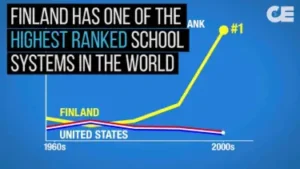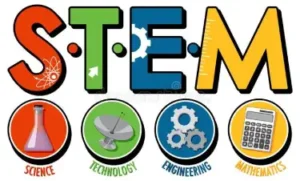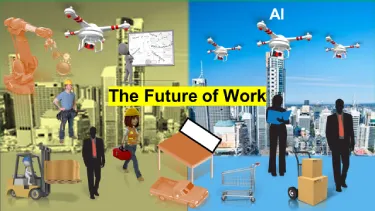Description: The Future of Work
Discover how AI is reshaping jobs, creating new opportunities, and how Australia can use its monetary sovereignty for a compassionate transition.
Introduction

Artificial Intelligence (AI) is transforming the job market at an unprecedented pace. As technology advances, some jobs are disappearing, while new professions appear. This comprehensive guide explores the future of work in the age of AI, detailing which jobs are at risk, which new opportunities are arising, and how displaced workers can be supported. The future of work is changing drastically.
I. Jobs and Professions at Risk of Disappearing
Automation and Job Losses
AI and automation are set to revolutionize many industries. According to a report by McKinsey Global Institute, up to eight hundred million jobs could be automated by 2030. This shift is not without its challenges, particularly for sectors heavily reliant on manual and repetitive tasks.
Examples of Jobs at Risk
1. Manufacturing and Assembly Line Jobs
– Robots and automated systems are increasingly performing tasks such as welding, painting, and assembly, reducing the need for human labor.
2.Data Entry and Administrative Roles
– AI-powered software can handle data entry, manage schedules, and perform routine administrative tasks more efficiently than humans.
3. Retail Cashiers and Customer Service Representatives
– Automated checkout systems and AI-driven chatbots are replacing traditional cashier and customer service roles.
4. Transportation (Drivers, Delivery Personnel)
– Self-driving vehicles and drones are beginning to take over driving and delivery tasks, potentially displacing millions of workers.
II. Emerging Jobs and Professions Created by AI
AI-Driven Industries and Opportunities

While AI is ending some jobs, it is also creating new opportunities in various fields. The demand for AI-related skills is growing rapidly, leading to the emergence of new professions.
Examples of New Professions
1.AI and Machine Learning Specialists
– These professionals develop and refine AI algorithms and systems. According to LinkedIn, AI specialists have seen a 74% annual growth rate in job postings.
2. Data Scientists and Analysts
– With the explosion of data, there is a high demand for experts who can analyse and interpret data to make informed business decisions.
3. AI Ethicists and Policy Advisors
– As AI becomes more integrated into society, there is a growing need for professionals who can address ethical issues and shape policies around AI use.
4. Robotics Engineers and Technicians
– These specialists design, build, and support robots used in various industries, from manufacturing to healthcare.
5. Cybersecurity Experts
– As AI systems become more prevalent, the need for cybersecurity measures to protect data and systems is increasing.
III. Supporting Workers Displaced by AI
Retraining and Upskilling Programs
To mitigate the impact of AI on the workforce, it is crucial to invest in retraining and upskilling programs. These initiatives can help workers transition to new roles and industries.
- Continuous Learning and Skills Development
– Workers need access to lifelong learning opportunities to stay relevant in the evolving job market. Platforms like Coursera and edX offer online courses in AI and related fields.
– Role of TAFE: A well-funded Technical and Further Education (TAFE) system can play a pivotal role in retraining the workforce. TAFE institutions can offer specialized programs in AI, machine learning, and other emerging technologies. By providing affordable, accessible education, TAFE can equip workers with the skills needed to transition into AI-driven industries.
– Specialized AI Programs: TAFE can develop comprehensive curricula focusing on AI, including courses on AI programming, data analysis, and AI ethics. These programs can cater to both beginners and those looking to advance their existing skills.
– Partnerships with Industry: Collaborating with tech companies and AI experts can ensure that TAFE courses are aligned with industry needs, providing practical, job-ready skills.
– Flexible Learning Options: Offering part-time, online, and evening classes can make it easier for working professionals to upgrade their skills without disrupting their current employment.
- Reintroducing Free Education
 – Access for All: Now is the time to reintroduce free education at all levels, ensuring that no one is disadvantaged in getting these necessary new skills. By removing financial barriers, individuals from all backgrounds can pursue education and training in AI and related fields.
– Access for All: Now is the time to reintroduce free education at all levels, ensuring that no one is disadvantaged in getting these necessary new skills. By removing financial barriers, individuals from all backgrounds can pursue education and training in AI and related fields.
– Government Investment: Significant government investment in free education can create a fairer society where everyone can thrive in the new economy.
– Long-term Benefits: Free education not only supports individuals but also helps the broader economy by creating a more skilled and adaptable workforce. This approach can drive innovation, economic growth, and societal well-being.
By using a well-funded TAFE system and reintroducing free education at all levels, Australia can create a robust framework for continuous learning. This ensures that the workforce stays competitive in the AI-driven job market and that every individual can succeed, irrespective of their financial background.
Education and Curriculum Reform
 The education system must adapt to prepare future generations for AI-driven industries.
The education system must adapt to prepare future generations for AI-driven industries.
- Integrating AI and Technology Studies
– Schools and universities should incorporate AI and technology courses into their curricula to equip students with the necessary skills.
- Encouraging STEM Education
– Promoting STEM (Science, Technology, Engineering, and Mathematics) education is essential for developing a skilled workforce capable of thriving in AI-driven environments.
Public Policy and Social Safety Nets
Effective policies and safety nets are vital for supporting displaced workers.
- Supportive Policies
– Implementing policies such as universal basic income and job transition programs can provide financial stability to workers during periods of unemployment.
- Case Studies of Successful Policy Implementations
– Countries like Finland and Canada have experimented with universal basic income pilots, offering valuable insights into how such policies can support displaced workers.
Role of Organizations and Industry
Businesses also play a critical role in managing workforce transitions.
- Corporate Responsibility
– Companies should take responsibility for reskilling their employees and providing support during transitions. For example, AT&T has invested $1 billion in retraining programs for its workforce.
- Leading Examples
– Organizations like IBM and Amazon have launched initiatives to retrain workers in AI and other emerging technologies.
IV. Preparing for an AI Future: Australia’s National Strategy
While training workers for AUKUS is a significant focus, Australia is also taking broader steps to prepare for an AI-driven future.
- National AI Strategy
Government Initiatives: The Australian government has launched the National AI Strategy to ensure the country can harness AI’s benefits while managing its risks. This strategy includes investments in AI research, development, and adoption across various sectors.
Funding and Resources: Allocating substantial funding to AI innovation hubs and research institutions to foster a thriving AI ecosystem.
Ethical AI Development: Establishing guidelines and frameworks to ensure that AI technologies are developed and deployed ethically, with a focus on fairness, transparency, and accountability.
- AI in Education
Integrating AI into Curricula: Incorporating AI and digital literacy into school and university programs to prepare the next generation for an AI-driven world.
Scholarships and Grants: Offering financial support for students pursuing studies in AI, data science, and related fields.
3. Industry Collaboration
Public-Private Partnerships: Encouraging collaboration between government, industry, and academia to drive AI innovation and ensure that workforce skills match market needs.
AI Adoption in Businesses: Supporting small and medium-sized enterprises (SMEs) in adopting AI technologies to improve productivity and competitiveness.
4. Public Awareness and Inclusion
Raising Awareness: Conducting nationwide campaigns to educate the public about AI’s potential and its impact on the job market.
Inclusive AI Development: Ensuring that AI benefits are distributed equitably across society, addressing digital divides and promoting diversity in AI development teams.
By implementing these measures, Australia is positioning itself to effectively navigate the challenges and opportunities presented by AI. The government’s comprehensive approach aims to foster innovation, economic growth, and societal well-being while preparing the workforce for the future.
V. Role of Organizations and Industry
Businesses also play a critical role in managing workforce transitions.
Corporate Responsibility
Companies should take responsibility for reskilling their employees and providing support during transitions. For example, AT&T has invested $1 billion in retraining programs for its workforce.
Leading Examples
Organizations like IBM and Amazon have launched initiatives to retrain workers in AI and other emerging technologies.
VI. Case Studies and Real-World Examples
Highlighting successful transitions can provide inspiration and guidance for displaced workers.
Individuals Who Successfully Transitioned
Stories of workers who moved from traditional roles to new professions in AI and technology can offer valuable lessons and motivation.
Lessons Learned from Previous Technological Shifts
Analyzing past disruptions, such as the Industrial Revolution, can provide insights into how societies can adapt to current changes.
VII. The Human Element: Addressing Concerns and Ethical Implications
Ethical Considerations of AI in the Workforce
As AI becomes more pervasive, addressing ethical concerns is crucial.
1. Ensuring Fairness and Equity
It is important to ensure that AI-driven changes do not exacerbate existing inequalities. Policymakers and businesses must work together to create equitable opportunities for all workers.
2. Addressing Potential Biases in AI Systems
AI systems can perpetuate biases if not designed and implemented carefully. Ensuring diversity in AI development teams and using unbiased data are essential steps.
The Psychological Impact on Workers
The transition to an AI-driven job market can be stressful for workers.
1. Managing Stress and Uncertainty
Providing mental health support and counseling services can help workers cope with the anxiety and uncertainty of job transitions.
2. Support Systems for Mental Health and Well-being
Creating supportive work environments and offering resources for mental health can alleviate the psychological impact of displacement.
Summary
In conclusion, AI is transforming the job market by eliminating certain roles and creating new opportunities. While this transition presents challenges, it also offers the potential for growth and innovation. By investing in retraining programs, reforming education, implementing supportive policies, and addressing ethical concerns, society can navigate this transformation and ensure a brighter future for all workers.
Thought-Provoking Question
How do you think AI will affect your profession in the next decade?
Call to Action
Stay informed and prepared for the future of work. Explore our resources for more insights on how to navigate the changes brought by AI.
Social Sharing
If you found this article insightful, please share it with your contacts and on your social media platforms to spread the knowledge.

